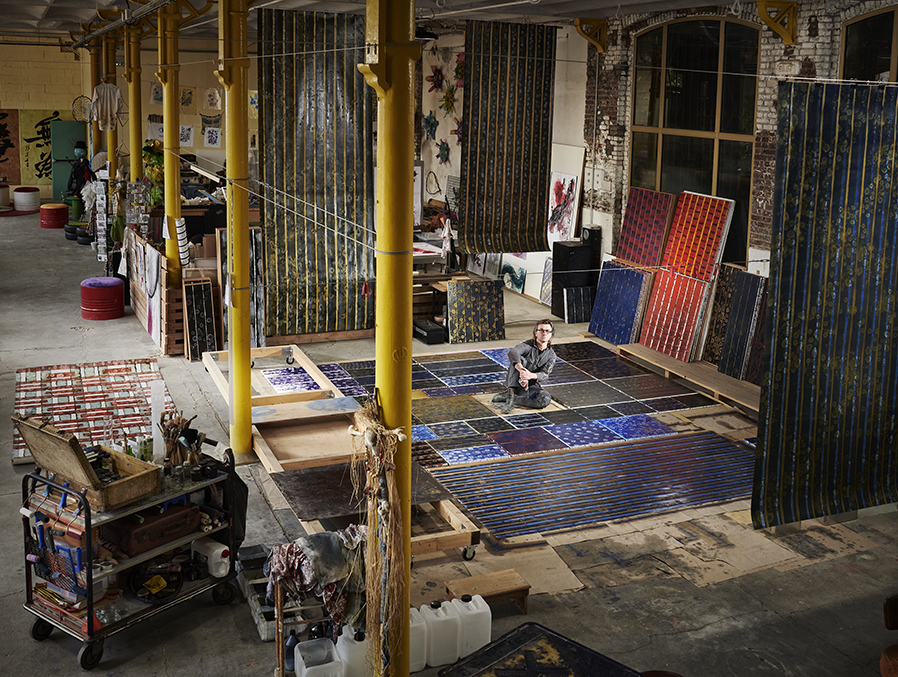Sébastien Kirch
Portrait d'artiste

S’en remettre au hasard :
entre science et spiritualité
Texte de Pascal Roux
Dans un atelier aux allures de ruche, un lieu témoin d’un passé industriel laborieux, se trouve un espace de création dans lequel Sébastien Kirch évolue avec aisance, lui qui développe un art tenant à la fois de l’alchimie et de la création artistique sensible et intime.
Son « processus » créatif est le résultat d’une longue gestation qui commence par le choix du fond de la toile (blanc ou or), pour y disposer ensuite des couleurs par bandes et par couches successives, construisant ainsi une harmonie que le peintre forme à son œil. Le temps fait alors son œuvre et c’est ainsi que commence la déconstruction, ou plutôt la mise en relation, ou en harmonie, des bandes sur la toile qui se relient entre elles sous l’effet de gouttelettes diluant la matière et reformant, ou déformant, un agencement en apparence cohérent. Plusieurs mois s’écoulent entre les différentes étapes de la création, laissant le soin à la peinture d’évoluer librement, parfois au-delà de l’intuition de son créateur, pour occuper tout l’espace de la toile.
Ce travail témoigne d’un équilibre réussi entre rationalité et spontanéité dans lequel le hasard joue un rôle prépondérant.
Mais il ne s’agit pas du hasard suscité par l’ignorance ou la méconnaissance d’éléments déterminants, mais bien du HASARD fondamental, ontologique, absolu que les scientifiques qualifieraient de « quantique » et dans lequel les spiritualistes pourraient y voir l’intervention de la main invisible d’un grand ordonnateur.
Dans le travail de Sébastien, le fond et la forme se confondent, le motif gagne son autonomie pour affirmer ce qu’écrivait Claude Viallat, un acteur majeur du mouvement Support-Surface : « l’objet de la peinture, c’est la peinture elle-même … ». Nul besoin de rechercher un sens ou un symbole, la matière, le geste, le résultat obtenu emportent l’émotion et se suffisent à eux-mêmes. Inutile, comme l’avait fait Georges Matthieu dans les années 50, de se demander si l’œuvre est signifiante ou non signifiante: elle existe, tout simplement.
Peindre est un besoin, pour certains une vocation, pour Sébastien Kirch certainement les deux à la fois. Peindre est aussi pour lui une expérimentation ou chaque travail est le début d’une démarche à la recherche du motif, de la meilleure posture, d’une émotion. Son regard est résolument tourné vers l’avenir et il sait que son travail actuel n’est qu’une étape ou encore un jalon, mais certainement pas encore un aboutissement.
Letting chance play its role :
between science and spirituality
Text by Pascal Roux
English translation by Patricia Murray
In a studio which is a hive of activity and in a place reminiscent of an arduous industrial past, Sébastien Kirch has found a creative space in which to evolve with ease and to perfect his art which blends both alchemy and sensitive personal artistic creativity.
His creative “process” is the product of a long period of preparation which begins with the choice of the background for the canvas (white or gold) before then applying strips of colour and successive layers of paint thereby allowing the artist’s eye to forge a harmonious entity. Time then takes over and the artist begins the deconstructing or rather the connecting or the harmonising of the bands on the canvas which interlink under the effect of the droplets diluting the paint and merge or separate to form a obviously coherent layout. Several months may lapse between the different creative steps allowing the painting to evolve freely to occupy the entire canvas, sometimes beyond what the artist originally imagined.
This work is proof of the successful balance between rationality and spontaneity in which chance plays a dominant role.
But it is not a simple case of chance born of ignorance or a poor grasp of essential elements but rather of basic, existential and absolute CHANCE which scientists call “random” and in which spiritualists might discern the influence of a higher being’s hand.
The background and the form merge in Sébastien’s work to become one, the motif breaks free to confirm the assertion by Claude Viallat, a major figure in the Support-Surface movement, that: “the aim of painting is the painting itself…”. There is no point in looking for a direction or a symbol, the material used, the gestures and the final result all convey emotion and suffice in themselves. It serves no purpose to ask oneself if the artwork is significant or not, as Georges Matthieu did in the 1950s: it quite simply exists.
For many, to paint is a necessity, for some it is a vocation, for Sébastien Kirch it is most definitely both. For him, painting is also an experimental process whereby each artwork is the beginning of a stage in the search for a motif, for the best positioning, for an emotion. He looks resolutely to the future and knows that his current work is but a step or a milestone but certainly not yet theculmination of his art.
